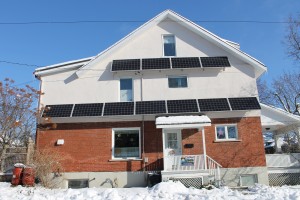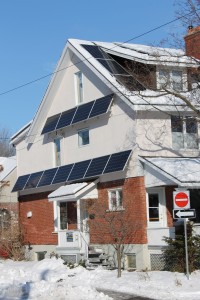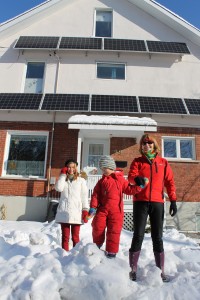Going Solar in 2013 √ɬĘ√Ę‚Äö¬¨√Ę‚ā¨Ňď A Gift that Will Keep on Giving
This year we gave ourselves solar electricity for Christmas. Of all the presents that my wife and I thought we wanted to give (and get), a rooftop solar electric system rated highest. So we split the cost and went for it. At $23,000 (once the $3000 in taxes are refunded) it is by far and away the biggest present we have ever given one another, and likely ever will. But this is a gift that will keep on giving; all year long, and indeed for 20 years or more.
This is also a present that gives in more ways than one. First, it will earn us 55 cents per kiloWatt hour, whenever the sun is shining. That should amount to the system (plus insurance and some miscellaneous additional expenses) paying for itself in about 10 years. Since our contract with the Ontario Power Authority is for 20 years guaranteed at this price, we would then make 10 years of profit. That√ɬĘ√Ę‚Äö¬¨√Ę‚Äě¬Ęs a pretty decent return on our investment. In a really good year, we might have done better with investments in stocks or mutual funds or something. But we have never been comfortable with the way our mutual fund investments have gone towards companies with dubious, or opaque ethical/sustainable practices. We have always wished we could invest more directly in products and services that better reflect our values.
Now we can! When the Ontario government created the Green Energy and Economy Act, and it√ɬĘ√Ę‚Äö¬¨√Ę‚Äě¬Ęs Feed-in-Tariff (FIT) and Micro-FIT programs, suddenly we and every resident of the province had a method for investing directly in renewable energy systems, with sufficient predictability to make a calculated investment decision. Individual Ontarians can decide if a solar, wind, micro-hydro, bio-fuel or other renewable energy project is where they wish to invest their savings, retirement funds or whatever. As millions of Germans know — because they pioneered this approach more than a decade ago √ɬĘ√Ę‚Äö¬¨√Ę‚ā¨Ňď this is a great way to place your savings knowing you will receive a fair return, at minimal financial risk. It is also a fantastic way to play a part in building a 21st Century energy system. One that is cleaner, more reliable (over a medium time period) and far less risky than nuclear, coal or gas-powered electricity are proving to be. There will be no solar panel blowouts in the Gulf of Mexico, no wind turbine meltdowns triggered by a tsunami or earthquake, and no deaths and hospitalizations from polluted air as a result of emissions from a bio-fuel generator or a small hydro turbine. There are some ecological impacts from each form of renewable energy, but nothing to compare with the one-time accidental risk or long-term climate consequences of our √ɬĘ√Ę‚Äö¬¨√Ö‚Äúconventional√ɬĘ√Ę‚Äö¬¨√ā¬Ě sources of energy.
Investing in your own Micro-FIT project or in a renewable energy co-op like Ottawa√ɬĘ√Ę‚Äö¬¨√Ę‚Äě¬Ęs OREC (Ottawa Renewable Energy Co-operative) is a way to say yes to a clean energy future. It is a way to say yes to local design and installation jobs. It is a vote for people taking ownership of their economy and ecological footprint.
Somebody has to take the initial leap, and the early investors like us are saying give me a predictable, guaranteed return (even with a modest payback of 10 years) and I will take that risk with my own money. I will sign a contract to sell you the electricity I generate, but only if I generate it. If I produce nothing, you pay me nothing. That cannot be said for large, centralized public or private power generators.
For the politically partisan reader, I have a strong message for 2013, a year in which a provincial election is quite possible: If you don√ɬĘ√Ę‚Äö¬¨√Ę‚Äě¬Ęt think the Green Energy and Economy Act is good enough, make it better. Don√ɬĘ√Ę‚Äö¬¨√Ę‚Äě¬Ęt scrap it. Tens of thousands of employers, college students, small companies, individual investors/voters and corporate investors are looking for stability and predictability. Not the perpetual flip-flopping on renewable energy that has characterized North America√ɬĘ√Ę‚Äö¬¨√Ę‚Äě¬Ęs tentative forays into cleaner energy. Canada and the United States are for the most part miles behind the leading countries, who are diversifying, shifting away from high risk sources and putting more power into the hands of ordinary citizens. That is why the Feed-in-Tariff is the policy of choice in more than 40 countries, and for hundreds of states and local municipalities. It makes renewable energy an investment choice, based on the real costs of production plus a modest profit. It does not reward large companies who will make massive profits, even if they fail to deliver the energy they have been paid to.
So, I say to opposition party leaders Tim Hudak, Andrea Horwath and Mike Schreiner: what will your Green Energy Act look like? How will you improve on this important leap forward here in Ontario? Scrapping the Act will set us way back. Indeed, just threatening to (Mr. Hudak) has put a major chill into investment in Ontario√ɬĘ√Ę‚Äö¬¨√Ę‚Äě¬Ęs clean energy industry. We deserve better. And to the Liberals and their soon-to-be-elected leader and new premier: what are your plans for improving the Act? How will you reduce the delays, allow for more local planning and ownership, improve transparency and upgrade the transmission infrastructure to make a truly smart grid a reality? And are you prepared to reevaluate your dependence on nuclear energy, and determine if the nuclear industry merits tens and likely hundreds of billions of additional public dollars at a time when most western countries are abandoning this costly and risky 50-year experiment?
For me and my wife, this gift of solar is a gift to ourselves above all because it earns us a decent return and it makes us feel good about aligning our money with our values. But we hope we aren√ɬĘ√Ę‚Äö¬¨√Ę‚Äě¬Ęt coming across too smug when we say that this is a gift to the world, humans and all other species that make up our amazing ecosystem. We see our new panels as a small contribution to nudging the course of humanity towards a more stable, enlightened and gentle course for 2013 and beyond.
Happy 2013 from David Chernushenko
PS Here are some technical specs for those who need to know:
System designed and installed by iSolara Solar Power – www.isolara.com
4.845 kW DC (Rated 4.085 kW AC) Solar Electric System, fully compliant with OPA Micro-FIT rules (60% Ontario content)
|




